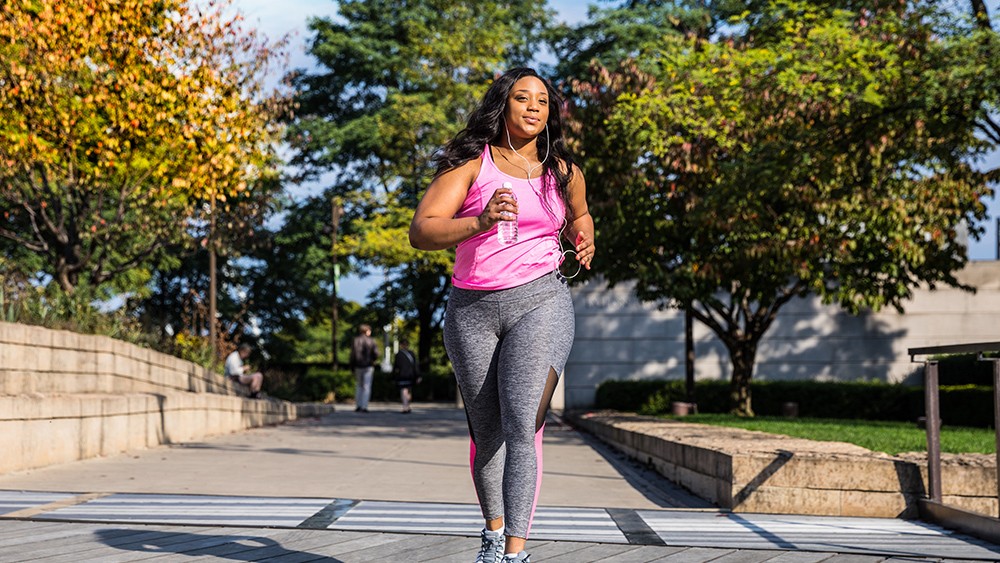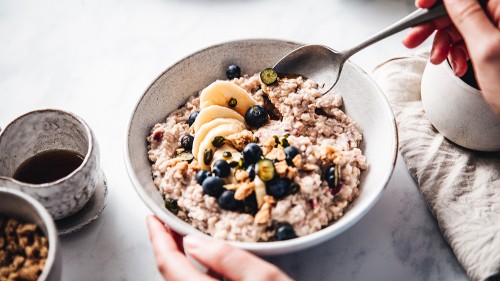Walking for Weight Loss Works: Steps and Tips to Getting Started
Last Updated on August 12, 2023
Reviewed by Ana Reisdorf, MS, RD
Walking is a safe, convenient, and effective form of exercise to lose weight. We’ll cover the essential steps to help you integrate walking into your daily routine to experience its multiple health benefits, including weight loss.


Key Insights (TL;DR)
- Walking is an effective form of exercise for weight loss. A 12-week study showed those who walked regularly lost more weight than those who did not. This was all while keeping their diets the same.
- You can expect to burn between 200–400 calories per hour from walking, depending on your weight, pace, and resistance level.
- For best results for weight loss, it’s recommended to walk a minimum of 5 days a week for 30 minutes each day, for a total of 150 minutes per week.
- If you’re new to walking, don’t rush the process. Start with walking for 10 minutes a day five days a week, and gradually increase the speed and duration every 2–3 weeks.
- Walking is a pretty safe form of physical activity. However, if you have an injury or arthritis, you may need to modify your walks or the type of terrain you walk on.
- Stretching is also crucial before and after your walks to loosen up your joints, prevent injury, and promote recovery.
Regular exercise is a key factor in losing weight and keeping it off. But what if common cardio exercises like running and high-intensity interval training are not for you?
The good news is that something as simple as walking can effectively help drop pounds. In fact, a 12-week weight loss study showed those who walked regularly saw a more significant reduction in their weight and fat mass and had a lower risk for heart disease than those who didn’t. (1)
Even though diet also plays a big part in weight loss, you will see more results by incorporating both diet and exercise into your routine. I have seen this to be true with many of my clients, where the ones who were walking as their primary form of exercise in addition to a healthy diet experienced results more quickly.
If you’re new to exercising or just prefer it over other workouts, walking can be a great way to get in shape, burn calories, and improve your health. We’ll cover all the important considerations below and offer a simple 3-step program to get you started with walking for weight loss.
Calories Burned During Walking
The number of calories you burn during walking is based on several factors, such as your weight, basal metabolic rate (BMR), sex, speed, and level of intensity.
Your BMR measures your metabolism and defines how many calories you burn in a given day at rest. The higher your BMR, the faster your metabolism is and the more calories you burn. (2)
Online calculators can estimate your calorie burn based on your demographics, distance, and pace.
On average, you can expect to burn between 200–400 calories per hour from walking at a moderate pace.
Here are some additional ranges for a quick comparison:
|
1-hour walk |
155-lb Person (Calories Burned) |
180-lb Person (Calories Burned) |
205-lb Person (Calories Burned) |
|---|---|---|---|
|
Under 2.0 mph (Very Slow) |
141 |
163 |
186 |
|
Walking 2.0 mph (Slow) |
176 |
204 |
233 |
|
Walking 2.5 mph |
211 |
245 |
279 |
|
Walking 3.0 mph (moderate) |
232 |
270 |
307 |
|
Walking 3.5 mph (Brisk Pace) |
267 |
311 |
354 |
|
Walking 3.5 mph (Uphill) |
422 |
490 |
558 |
The above ranges are only an estimation. The best way to determine your actual calorie burn is to wear a heart rate monitor, a fitness tracker, or a smartwatch. You can record your walk with these devices, tracking your pace, heart rate, and the number of calories you burn.
Important Considerations When You’re Starting Out
- Prepare what you need for walking: Make sure you have comfortable, weather-appropriate clothes and sneakers for walking.
- Proper form and walking techniques: Walking for weight loss requires a specific form and technique to maximize effectiveness. Effective walking means taking long strides, not slouching, and using your entire body by engaging your arms and legs. If not, you will lose out on some of the benefits.
- Set a walking schedule: Set realistic expectations to set yourself up for success. Figure out when, where, and for how long you will walk. Plug your walking dates/times in your calendar, so it’s automatically part of your day, not just something you’ll get to if there’s time. You don’t have to start full force and walk an hour each day. Instead, you should start slow and establish a routine first.
- Hold yourself accountable: Consider having a walking buddy or an accountability partner for your walks. This can be a friend or close family member with whom you share your walking goals. Sharing your goals with someone else may make you more likely to stick to them because you know someone may be checking in on you. Having a walking buddy also can make the walk more enjoyable and harder to bail on.

3-Step Bullet-Proof Walking Program to Get Results
When starting a walking program or any other exercise program, it’s easy to adopt the all-or-nothing mentality and dive in full force. However, being patient with the process and taking it slow will help build an exercise habit that can last a lifetime.
Here are three easy steps on how to start your walking for weight loss program:
Step 1
Start with a goal of walking 10 minutes a day at a 3.0–3.5 mph pace. Do this for three weeks without changing anything. Doing this consistently builds the initial habit and makes it part of your routine.
Step 2
Slowly increase the amount of time you walk by 5 minutes every week. Do this until you can walk 30 minutes per day without stopping. This helps you stay challenged and increase your chances of losing weight and seeing the desired results.
Step 3
Once you start walking 30 minutes per day for at least three weeks, you can start to increase the time, pace, and level of intensity of your walks. For example, you can speed up your pace or walk up hills instead of a flat road. Adding these extra challenges will bring more results.
Make Your Walks More Rewarding, Interesting, and Effective
If you’re walking regularly, you want your walks to be an effective use of your time and exciting. There are several fun ways to kick your walks up a notch and torch additional calories for weight loss.
Listen to Music
If music gives you energy, try turning up the volume during your walks. Because music brings on a lot of positive emotions, it may lead you to increase your speed and intensity without even realizing it. Music can also make the time go faster if you’re doing a long walk.
Add Weights
As you get comfortable in your walking routine, you can try adding in some light hand or ankle weights. Add a set of 3–5 pound dumbbells while you walk, or strap on 3-pound ankle weights to challenge yourself. This will help further increase your heart rate and calorie-burning potential and doesn’t take extra time! Remember to do this in moderation, and don’t force yourself to do this with every walk, especially if you’re just starting a routine.
Do Intervals
Instead of walking at the same pace the entire time, try breaking up your walk into intervals. For example, walk at 3.0 mph for 5 minutes, then 4.5 mph for 5 minutes, and then repeat that pattern for the duration of your walk.
These intervals challenge your body and increase your heart rate, which helps burn more calories than staying at a steady pace. Intervals are a great way to increase your walk’s intensity. They can be particularly effective for weight loss and targeting stubborn abdominal fat. (3)
Track Your Progress
Track your walks daily using a fitness tracker or smartphone app and measure your stats every week. This will help you determine your baseline so you know where you’re starting from. If you don’t know your baseline, it’s easy to continue doing the same thing every day. Your body will get used to always doing the same thing, leading to a weight loss plateau. (4)
As you improve with your walks, you can directly see your progress, such as walking faster or further, which will motivate and encourage you to push harder.

Find Hills
If you have some hilly areas near you, try mixing it up and walking there on certain days. Walking uphill helps you burn more calories, improves your metabolism, and even works out your leg muscles. Specifically, on average, walking on hills burns about 150 calories more per hour than on a flat surface. (5)
Change Things Up, Including Scenery
You don’t always have to walk the same path every time. Mixing up your routine and location will offer additional challenges and keep things interesting.
Try different neighborhoods, terrains, locations, or walk with a friend, so there is always something new to see. Also, try exploring more nature-based routes. In fact, a 2019 study showed that being in beautiful nature for 120 minutes per week helps elevate mood and well-being and is effective for walking. (6)
Walking in different areas and finding hills adds challenge, which can push you past your comfort zone when you’re ready.
Walking Benefits for Weight Loss Explained
Walking can help you lose weight in several ways:
It Improves Physical Fitness
Walking strengthens your heart and lungs, which builds your physical fitness and endurance. And the more physically fit you are, the more calories you’ll burn for weight loss.
It Improves Your Mood and Mental Health
The act of walking is a natural mood booster, and it does this by producing endorphins — hormones that can put you in a better mood. (7)
It can also ward off negative feelings that lead to poor eating habits. There is a real stress-diet relationship, so any activity that improves your mood can also support your efforts to eat healthier for weight loss. (8)
It Burns Calories
On average, walking 3 miles per hour burns about 150 calories per 30 minutes. This calorie burn number can range depending on your pace, environment, and resistance level.
Just imagine if you walked for 60 minutes every day for a week, you’d burn over 2000 extra calories in a given week from that alone!
It Reduces Body Fat
Walking is a form of cardio exercise that effectively burns fat. In particular, walking has been seen to target belly fat and reduce inches around the waistline. In one study, those who walked for one hour five times a week lost more belly fat than those following a diet alone. (9)
It Increases Muscle Strength
Walking doesn’t just burn fat — it’s also a great way to improve the tone and definition of your muscles. It is a full-body workout and therefore targets most major muscle groups. And when you have more muscle, your body burns more calories, which can support weight loss. (10)
Additional Benefits
- Reduces the Risk of Heart Disease or Stroke: According to research, walking is one of the first steps recommended for heart disease prevention. (11)
- Regulates Blood Sugar Levels: Whether you have diabetes or not, walking is a great way to keep your blood sugar in a healthy range. When walking briskly, your muscles will utilize the glucose (blood sugar) more effectively in your blood, so it doesn’t stay in your blood. (12)
- Low-Impact: Walking by nature poses a low risk of injury, which can be helpful for someone prone to injury or who was injured in the past.
The Bottom Line

Exercise is essential when it comes to losing weight and keeping it off. The good news is that if you aren’t a fan of high-intensity workouts, walking can help you burn calories and get in shape.
The key to walking is making it something you genuinely enjoy. Once this happens, you will stick to it long-term, achieve your weight loss goals, and improve your quality of life.
So, start walking today, and we hope you’ll love it as much as we do!
Put It Into Action
If you are ready to start, take a piece of paper or your favorite note-taking app and do the following:
- Think about why you want to start walking and how your life could be improved. Set specific goals. (For more on goal setting, we invite you to read our Exercise for Beginners guide.)
- Identify what gear you need to get started and set a time in your schedule to get everything ready.
- Set a start date and schedule five 10–30 minute slots in your calendar for the first week.
- Set a 15-minute session at the end of the week to review your goals, reflect on your progress, assess what went right, improve what went wrong, and plan the following week. We also recommend rereading this article.
- Repeat the process weekly.
At WellnessVerge, we only use reputable sources, including peer-reviewed medical journals and well-respected academic institutions.
- Moderate Walking Enhances the Effects of an Energy-Restricted Diet on Fat Mass Loss and Serum Insulin in Overweight and Obese Adults in a 12-Week Randomized Controlled Trial:
https://academic.oup.com/jn/article/147/10/1875/4727967 - Examining Variations of Resting Metabolic Rate of Adults: A Public Health Perspective:
https://www.ncbi.nlm.nih.gov/pmc/articles/PMC4535334/ - High-Intensity Intermittent Exercise and Fat Loss:
https://www.ncbi.nlm.nih.gov/pmc/articles/PMC2991639/ - Maintenance of lost weight and long-term management of obesity:
https://www.ncbi.nlm.nih.gov/pmc/articles/PMC5764193/ - Predicting the Metabolic Cost of Incline Walking from Muscle Activity and Walking Mechanics - PMC:
https://www.ncbi.nlm.nih.gov/pmc/articles/PMC4504736/ - Spending at least 120 minutes a week in nature is associated with good health and wellbeing | Scientific Reports:
https://www.nature.com/articles/s41598-019-44097-3 - Exercise-, nature- and socially interactive-based initiatives improve mood and self-esteem in the clinical population:
https://journals.sagepub.com/doi/10.1177/1757913910393862 - Stress and Eating Behaviors:
https://www.ncbi.nlm.nih.gov/pmc/articles/PMC4214609/ - Dose-response effect of walking exercise on weight loss. How much is enough?:
https://pubmed.ncbi.nlm.nih.gov/12439651/ - Increasing muscle mass to improve metabolism:
https://www.ncbi.nlm.nih.gov/pmc/articles/PMC3661116/ - Walking – the first steps in cardiovascular disease prevention:
https://www.ncbi.nlm.nih.gov/pmc/articles/PMC3098122/ - Benefits of Walking | ADA:
https://diabetes.org/healthy-living/fitness/benefits-walking






